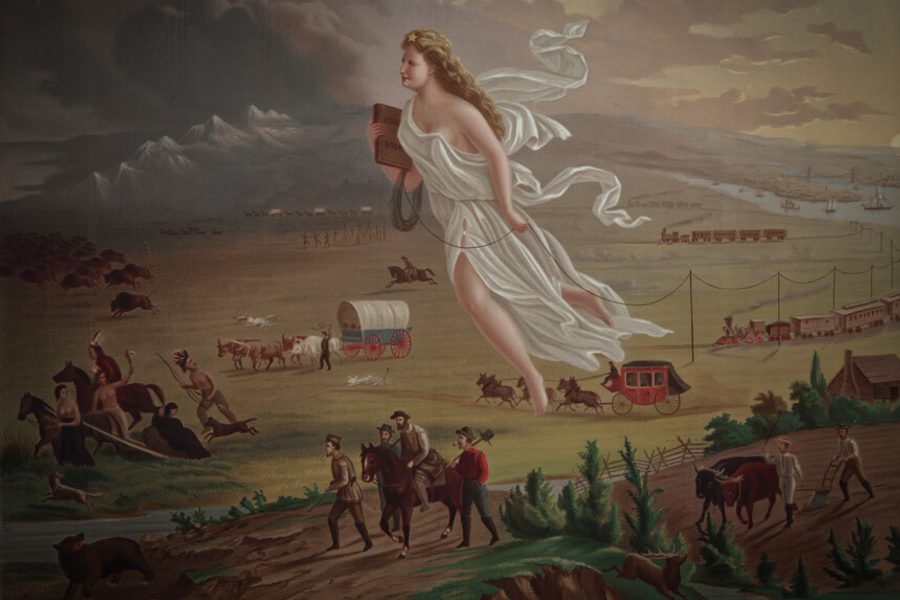Colonial State of America
In a new book, Roxanne Dunbar-Ortiz unearths our bloody origins.
Jeremy Gantz

A few weeks after his first inauguration, President Barack Obama sat for an interview with the al-Arabiya news network. “We have not been perfect,” he said. “But if you look at the track record… America was not born as a colonial power.”
The idea of the United States as a peaceful democracy at heart, occasionally pulled into overseas wars, is a comforting verse in the national gospel. It’s part of the origin story told in high school textbooks: A fledgling nation threw off the yoke of British colonial rule and settled the West to become the world’s indispensable democratic nation. Sporadic imperial fits notwithstanding (e.g., the invasions of the Philippines, Vietnam, Iraq), the soul of America “goes not abroad in search of monsters to destroy,” as John Quincy Adams once said.
In An Indigenous Peoples’ History of the United States (Beacon Press), Roxanne Dunbar-Ortiz dismisses this story as “patriotic cant” — a piety recited by President Obama and his predecessors to cover up the country’s violent colonial DNA. A retired California State University professor who is part Native American, Dunbar-Ortiz served as an expert witness for American Indian Movement activists put on trial following the deadly 1973 protest at Wounded Knee.
Culminating her nearly half-century career as an activist-academic dedicated to justice for Native people, her concise and disturbing new book dismantles culture national myths to reveal the country’s true foundation: a land grab that required the government-sponsored erasure of millions of indigenous people. Before the start of European colonization, an estimated 15 million Native people lived in what is now the United States. Their descendants number 3 million today, spread across 500 different federally recognized nations. A lack of immunity to European viruses accounts for much of the devastation, but not all. Rebuking the trope that Indians were doomed to die from epidemic diseases, Dunbar-Ortiz writes: “If disease could have done the job, it is not clear why the European colonizers in America found it necessary to carry out unrelenting wars against Indigenous communities in order to gain every inch of land they took from them.”
For example, to accomplish George Washington’s goal of securing southern Ohio for settlement, in 1790 Secretary of War Henry Knox told an army commander that “no other remedy remains, but to extirpate, utterly, if possible,” the “savages.” Volunteer militias made up of settlers, hungry for land or scalp bounties, proceeded to wage total war, murdering women and children.
Slavery is called the United States’ original sin, but the displacement and genocide of American Indians is truly that — in the sense of originating. But because celebrating democracy requires condemning colonialism, Americans have been unable to face the country’s true origins. Dunbar-Ortiz writes, “The myth persists, not for lack of free speech or poverty of information but rather the motivation to ask questions that challenge the core of the scripted narrative of the origin story.”
An Indigenous Peoples’ History isn’t just asking questions. It is a fiercely argued polemic concerned less with uncovering the historical record than distilling it into something that Americans cannot ignore. Dunbar-Ortiz has written a slender book that aims to replace “the master narratives and politics that…have largely covered the fingerprints of centuries of genocide.”
While she highlights lesser-known figures like Knox, the chief villain in these pages is far more familiar: He’s on the $20 bill. After becoming a national military hero by killing and evicting Indians across the South, in 1828 Andrew Jackson brought an unrelenting policy of ethnic cleansing into the White House, forcing the remaining Indigenous communities east of the Mississippi to head west. Unlike most government-sponsored atrocities toward American Indians, the “Trail of Tears” is relatively well-known today. Dunbar-Ortiz’s treatment of Jackson, however, goes beyond the awful details, and is a provocative high point of An Indigenous Peoples’ History. Jackson, she writes, was the “Dark Knight in the formation of the United States as a colonialist, imperialist democracy, a dynamic formation that continues to constitute the core of U.S. patriotism.” In other words, Jackson’s simultaneous aggression and popularity forged a template that succeeding presidents would follow: Make war, win votes.
In her estimation, Obama is following Jackson’s successful playbook by “advancing populist imperialism while gradually increasing inclusion of other groups beyond the core of descendants of old settlers into the ruling mythology.” But how exactly is he advancing “imperialism” today, and which groups are being brought into the ruling order? We’re left wondering.
Yes, the 19th-century wars to “close the frontier” were the crucible in which the U.S. Army came of age and staged its first counterinsurgency. But the idea that current American military habits stem directly from that experience stretches the imagination (Her proof: Soldiers still sometimes refer to enemy territory as “Indian country”). At a deeper level, though, Dunbar-Ortiz is right to trace Americans’ comfort with an aggressive global military presence back to an unacknowledged but formative colonial history. Born through war, the “colonialist settler-state,” as she calls it, goes abroad to spread democracy, often through violence. The book’s biggest problem is a conclusion titled “The Future of the United States” that offers a hodgepodge of recent history followed by only two paragraphs that lay out a vision of justice for Native peoples.
Is there reason to hope? As this book makes clear, the colonial project of marginalizing indigenous peoples lives on today in reservations heavily dependent on the U.S. government, in deeply impoverished communities suffering from rates of unemployment, alcoholism, suicide and domestic violence far higher than national averages. Reparations from Washington are beyond far-fetched when Congress can barely allow tribal courts to prosecute non-Native men who commit rape on reservations, as it did in last year’s reauthorization of the Violence Against Women Act. When only three presidents since Franklin Roosevelt have made an official visit to Indian country — one of them being Obama, this June, more than five years into his presidency — it’s clear that justice for native peoples isn’t a national priority. Even Congress’ first-ever official apology to native peoples — avoiding the word “genocide,” of course — was inserted into an obscure 2010 defense appropriations bill to gain passage.
That subpar, purely symbolic mea culpa is fitting for a country so bad at looking backwards and so good at feeling good about itself. If you want to bypass the official story and learn how the United States colonized a continent, Dunbar-Ortiz’s anguished history is a good place to start.
Jeremy Gantz is an In These Times contributing editor working at Time magazine.









